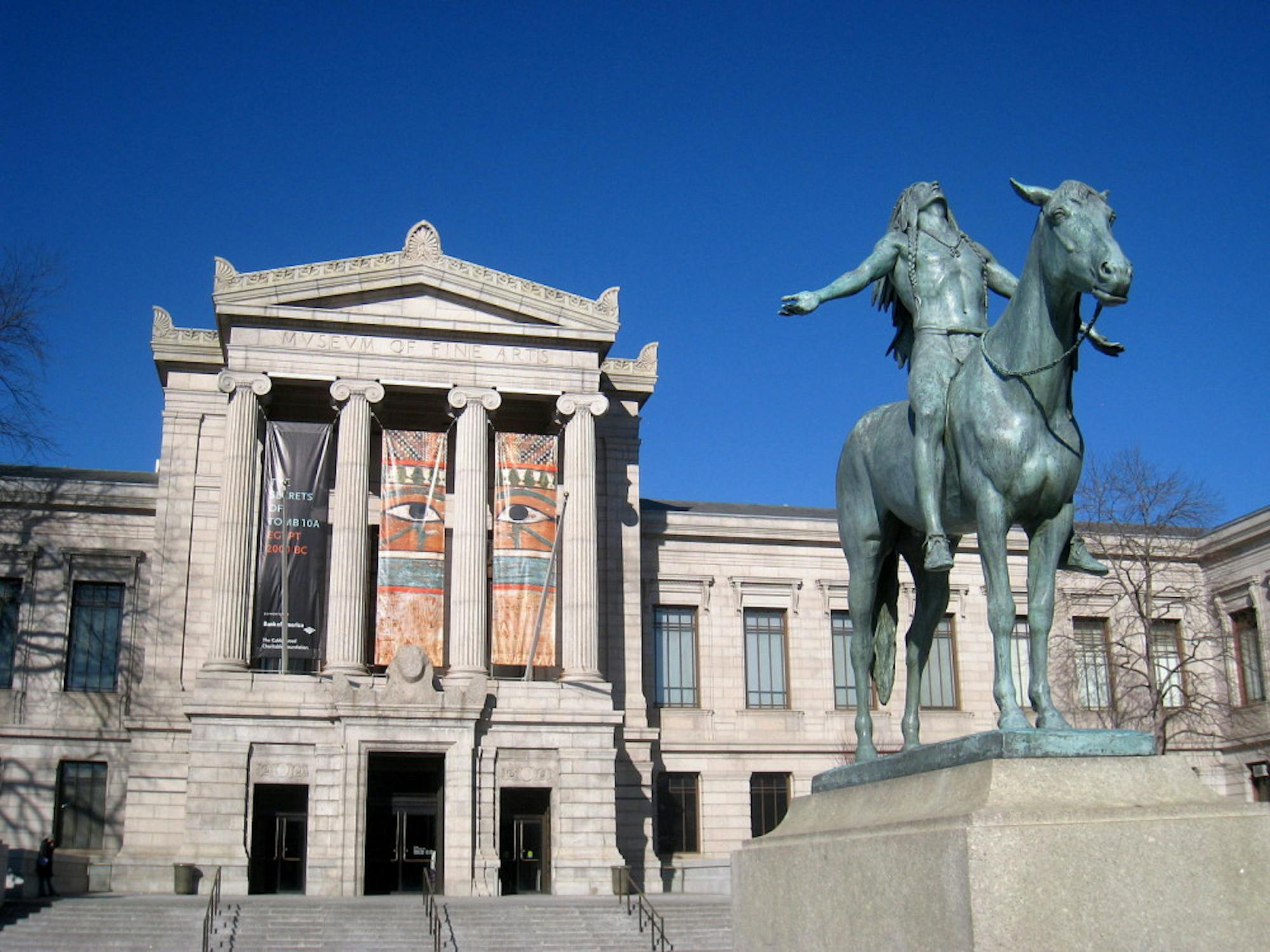The door of the Charlotte F. and Irving W. Rabb gallery at the Museum of Fine Arts, Boston (MFA) is now open to an alternative universe. From Feb. 3 to May 28, the gallery is dedicated to the first display of the fantastical prints and drawings by Dutch printmaker M.C. Escher.
M.C. Escher (1898–1972) was born in Leeuwarden, Netherlands. After studying at the School of Architecture and Decorative Arts in Haarlem from 1919 to 1922, Escher embraced his passion for printmaking. It seems Escher was incredibly sensitive to geometry’s paradoxical perfection of mathematical shapes and unreasonable optical illusions. Escher was particularly intrigued by symmetry for its allusion to reflection, a concept that he found fascinating.
Escher’s early works of nature are simultaneously familiar and sentimental. “Rippled Surface,” a color linocut created in 1950, depicts a disturbed reflection of the moon and tree branches in water. The silhouettes of the branches are rendered flat by an unvaried hue of black. The moon, a piece of white negative space, only stands out in contrast to its surrounding, dim brown background. It doubtlessly conforms to the stereotypical connotation of the moon as a reserved and feminine goddess. The quiet scenery poetically captures the positive aspect of loneliness, as a widely beloved conduit for self-reflection. The two systems of concentric ellipses represent water ripples, adding movement to the otherwise still image, and reveal the imageries of the moon, the night sky and the tree branches as water reflections. The ripples threaten the viewers against engaging deeply with the imagery by revealing the piece's illusory and ephemeral nature.
Escher’s fascination with reflections is even more evident in “Puddle.” The 1952 color woodcut depicts a puddle among footprints and wheel marks on a muddy road. In the puddle is another reflection of silhouettes of trees, the moon and the night sky. This woodcut is especially reminiscent of Japanese art, both visually and thematically. The apparent outlines in the scene give the figures an almost cartoonish character, resembling the countryside scenes in Miyazaki films. The general use of fine lines in “Puddle” creates texture and depth, alluding to the meticulous delineations in traditional Japanese paintings and ukiyo-e prints.
“Puddle” speaks to the spirit of Japanese art on a deeper level through the adoption of the principle of wabi-sabi, the appreciation of the imperfect. In Japanese art, wabi-sabi can be embedded in various structures and textures, such as asymmetry in architecture and cracked porcelains. Similarly, all the subjects in “Puddle” are, in a sense, incomplete. Neither the road nor the reflections in the puddle are visually continuous; the puddle conceals the patterns in the middle of the road, while the corrugations on the road essentially intersect and bound the reflections in the puddle. The footprints on the road are similarly incomplete as representations of people. Desolation lies at the core of “Puddle,” a depiction of presence through absence, emotional ecstasy through loss.
Notably, the very process of printmaking is one of reflection. The printmaker etches patterns and outlines on a hard surface before replicating them on paper. The final prints are literal mirror images of the carved surfaces. Printmaking also relates to reflection conceptually via the prints' removal from their respective prototypes. The relationship between the artist and the artwork in printmaking is much less intimate than that in drawing or painting. The printmaker is partially deprived of control over the final product by the intermediate step of carving. Similarly, reflections are inevitably distorted reproductions of the physical objects or images they mirror.
Escher’s later, more surreal prints are based on repetition and metamorphosis. “Circle Limit III,” a 1959 color woodcut, depicts a myriad of fish organized so geometrically and symmetrically that there is no negative space left in the round image. The size of the fish decreases as the fish radiate from the center of the circle to its edge. However, the structure of each individual fish and the organization of the school of fish remain the same. The consistency in these frameworks of the overall image touches upon the concept that all beings are essentially the same, and corroborated by the prevalence of mathematical concepts such as the golden ratio and the Fibonacci sequence in nature.
Meanwhile, “Metamorphosis II” (1939–1940) illustrates the cyclical nature of time and invokes the concept of reincarnation. The incredibly long and panoramic color woodcut starts and ends with crossword puzzles with only the word “metamorphose,” but it gradually morphs into other patterns and figures as the viewer's eyes move toward the middle. The gradual change from one substance to another shown in “Metamorphosis II” also suggests the essential sameness among all existence in the universe. The identical ends of the print allude to the repetition of life cycles through reincarnation.
By installing two almost identical entrances to the exhibition, which are also exits, the MFA’s curatorial staff created a space that resonates with the theme of repetition and cycles in Escher’s works. As some visitors enter, others exit. The end and the beginning coincide, and so do life and death symbolically.
The magical space that Escher’s works and the MFA’s curatorial team created invites visitors to both stretch their vision to the land of imagination and scrutinize the familiar world from quirky perspectives, both literally and metaphorically.
M.C. Escher is reborn at the Museum of Fine Arts

The Museum of Fine Arts in Boston, Mass. is pictured on January 16, 2010.
Summary
The MFA's M.C. Escher exhibit invites visitors to get a sense for Escher's perception of the cyclical nature of the universe.
4.5 Stars





